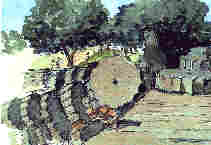Olympia
Sanctuary of Zeus and venue of the ancient games

| Journey
through Ancient Greece Olympia Sanctuary of Zeus and venue of the ancient games |
|
| The site at Olympia is large and
beautiful, with olive, plane and pine trees, planted by
the German archaeologists in the 1930s, giving plenty of
shade for your picnic. Sadly the site was flattened by earthquake and although the 20 feet of sand and debris which built up protected many wonderful artefacts, which can be seen in the museum, the buildings remain largely piles of stone and require a good deal of imagination to picture. (There are 2 excellent models of the site in the museum.)
Here the
Greeks erected statues and built temples in a grove
dedicated to Zeus, supreme among the gods. You
enter the sacred site on a long level track. and come
first to the gymnasium and the Palaestra
(wrestling school). The stadium has been restored to its 4th century state when 30,000 spectators watched from the earth embankments. The Temple of Zeus was built in 470-456 BC; it was as large as the Parthenon and made of limestone originally faced with stucco. The temple's decoration rivalled that of the Parthenon with superb sculptures of the Lapiths and centaurs, and the chariot race of Pelops now in the museum. Sadly the 40' high ivory and gold statue of Zeus, created by the sculptor Phidias, and considered one of the Seven Wonders of the World, which stood in the naos has not survived. |
 |
The Museum contains many exquisite finds from the site, don't miss: |
|